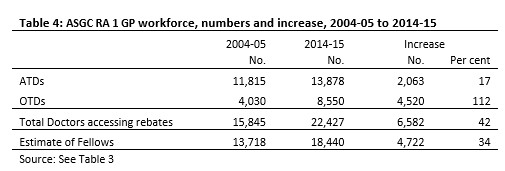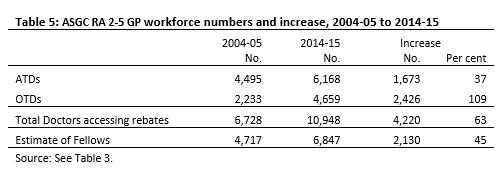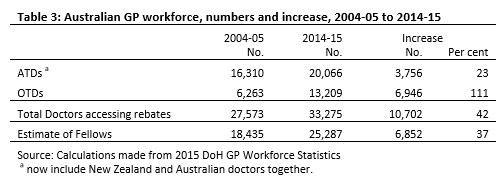I wrote yesterday how there has been a flood of overseas-trained doctors (OTDs) into Australia over the past decade, whose numbers have ballooned-out by a whopping 111%:
And that these OTDs have driven a 47% rise in the total number of doctors in the decade to 2014-15, around 2.5 times the 19% growth in the Australian population.
Moreover, most of these OTDs are practicing in over-supplied metropolitan (RA 1) areas, not areas of perceived shortage in the regions (RA 2-5):


And they are largely responsible for the blow-out in Medicare rebates:
The OTDs influx is therefore responsible for most of the growing oversupply of GPs in RA 1 locations. They are also responsible for most of the increase in Medicare service costs. By June 2015, for all of Australia, OTDs made up 39.7 per cent of the workforce but received 49.8 per cent of total rebates. In RA 1 areas they made up 38.1 per cent of the total workforce and received 47.6 per cent of services paid for by Medicare.
The consequences of which are a continued blow-out in bulk-billed GP visits and Medicare funding costs.
Today, the Herald-Sun has produced a report on the thousands of medical workers (mostly GPs) being brought into Australia, which has caused a backlash from the Australian Medical Association (AMA):
Of the 2618 government-sponsored 457 workers who arrived during the 2015-2016 financial year, 2268 were health professionals.
They included 1692 general practitioners and resident medical officers, 228 registered nurses, 35 specialists, 38 psychiatrists, 28 surgeons, 19 anaesthetists and 20 midwives.
…the Australian Medical Association said labour market testing for medical practitioners was not mandatory, and the system should be changed.
The AMA’s Victorian president, Lorraine Baker, said Australia had had a shortage of doctors a decade ago.
She questioned why large numbers of doctors were still being brought in from overseas when this was no longer so.
“Across Australia, there has been a 150 per cent increase in medical school places since 2004,” Dr Baker said.
“Unsurprisingly, this has led to a bottleneck pressure to train these junior doctors, to such an extent that there are now unemployed junior doctors in Victoria,” she said.
Dr Baker also said that the 457 visa scheme had not addressed the “maldistribution” of doctors.
“There is still a shortage of doctors in some rural areas, while at the same time there is high density numbers in inner-metropolitan areas,” she said.
Thankfully, moves are afoot to stem the flow of OTDs, with the Health Department looking to remove 41 health roles from the official skills shortages list. From The Australian:
The department wants 41 health roles — including general practitioners, resident medical officers, surgeons and anaesthetists — to be removed from the Skilled Occupations List in the hope that Australian doctors will fill areas of need, particularly in remote areas. While its recommendations were not accepted by the Turnbull government in visa changes made before the election, they will be revisited within months and Health Minister Sussan Ley has foreshadowed broader workforce reforms next year…
The Health Department, in its unpublished submission to the latest review of the Skilled Occupations List, sees a wave of Australian-trained doctors coming into the system and fears the public investment in their skills will be squandered…
“Immigration is often used as a short-term demand management strategy and it continues to be poorly co-ordinated … Over a longer planning horizon, better management of migration pathways for international health professionals must occur in combination with all commonwealth departments … and the analysis must include evolving training and reform strategies.”
Good to see. But why stop at health professionals? The latest skills shortages report from the Department of Employment found that “the proportion of skilled occupations in shortage remains low by historical standards”, and that there are way too many university graduates chasing too few jobs.
So why are we allowing the widespread importation of so-called “skilled” 457 visa workers when there is a large pool of locals that could do the jobs?


